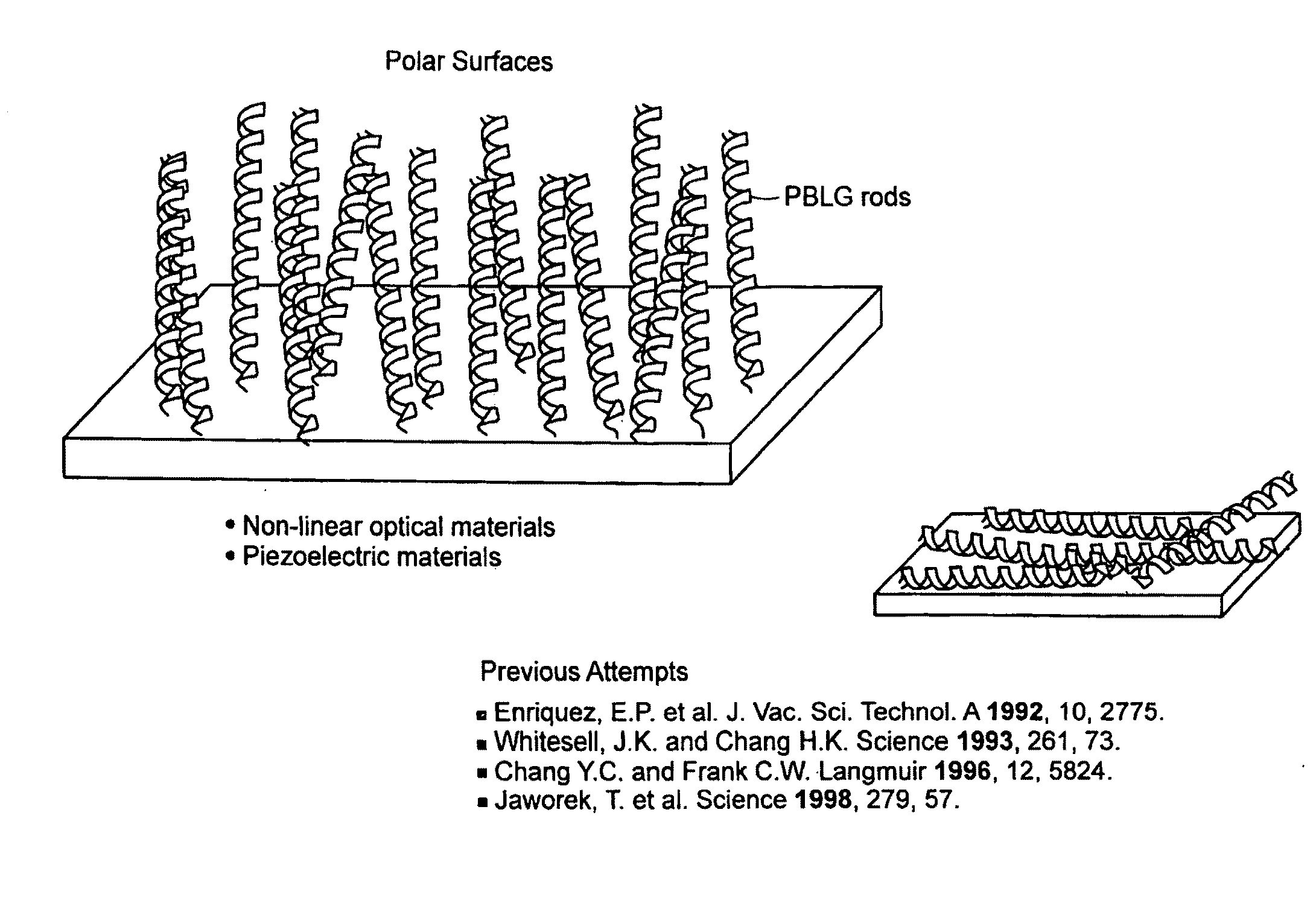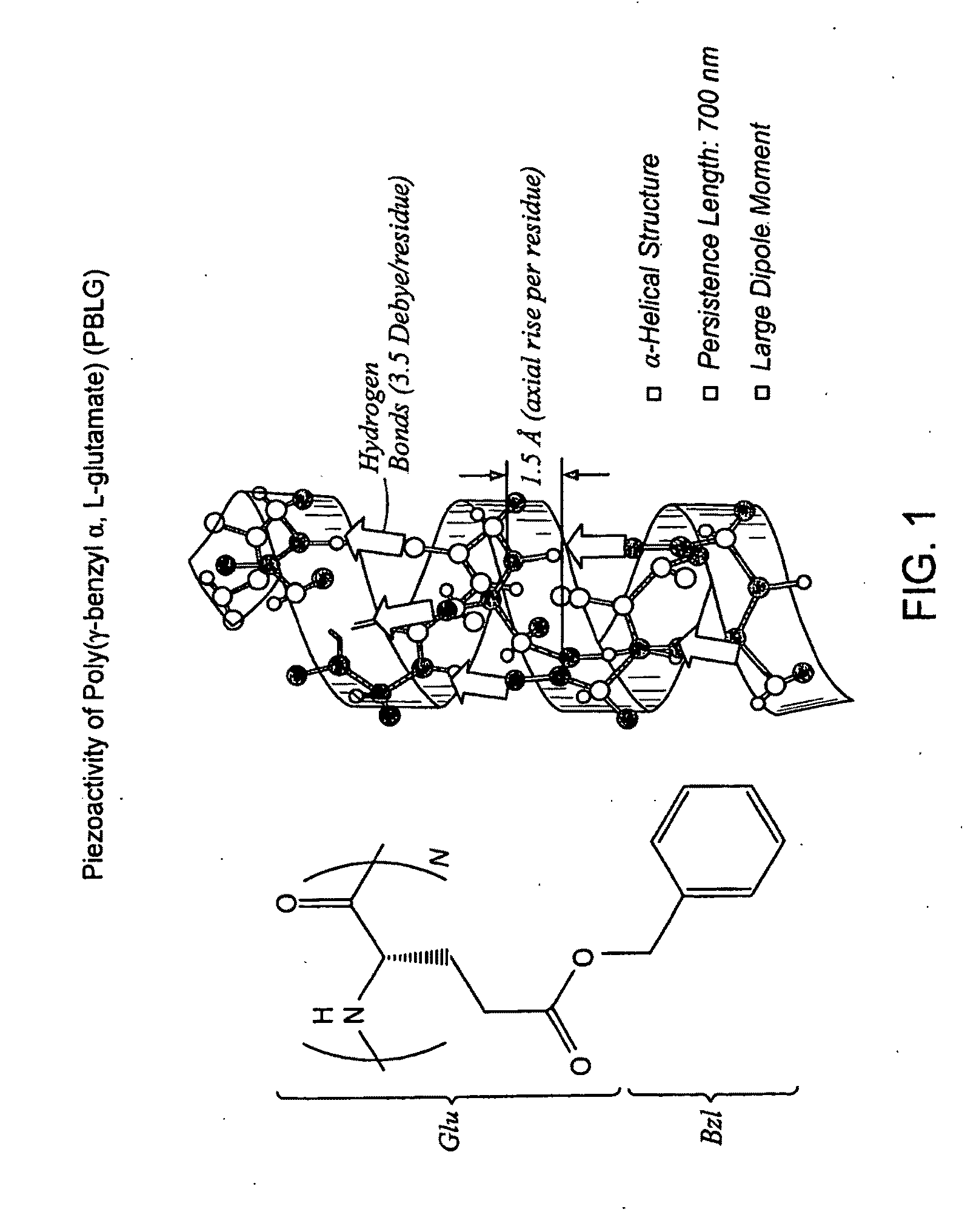Piezoelectric compositions
a technology of organic resin and piezoelectric materials, applied in the field of piezoelectric organic resin blend, can solve the problems of brittleness and require special processing conditions, affecting the performance of piezoelectric materials, and requiring high processing costs, so as to improve the performance of conventional products
- Summary
- Abstract
- Description
- Claims
- Application Information
AI Technical Summary
Benefits of technology
Problems solved by technology
Method used
Image
Examples
example 1
[0137]For a polypeptide, PBLG has unusually high solubility in organic solvent and is able to form concentrated lyotropic liquid crystalline phases. PBLG remains in piezoactive α-helical form in solutions and even in solid state after solvent is evaporated. This extreme solubility and helical stability allowed for the use of PBLG-polymer composite materials for the development of flexible piezoelectric films. Since PBLG solutions and most other conventional polymer solutions are not miscible, it was decided to fabricate the composite film by polymerizing / curing a monomer-PBLG mixture solution. Before fabrication of the composite, it was important to first show that the PBLG-PMMA solution would polymerize to form a stable composite film, while maintaining the piezoelectrically active alpha-helical conformation. In addition, it was also needed to verify that macroscopic phase separation did not exist in the polymer. When the solubility of PBLG in various polymerizable liquid monomers ...
example 2
[0139]In order to form polar PBLG-PMMA composite film of high d33 piezoelectricity, it was decided to employ corona charging to pole the PBLG rods and orient the rods in the direction perpendicular to the film surface. Corona charging is commonly used to render polymers piezoelectric. Corona is a preferred method for poling the PBLG rods because it allows us to expose the system to extremely high fields. Corona also aids in the polymerization process, which was discovered when curing the composite without the initiator. Although breakdown charging would be an alternative method for poling, the limitations of the test equipment would not allow the accommodation of a liquid solution prior to polymerization.
[0140]When corona was applied to the PBLG-MMA-AIBN mixture solution at 60° C., the volatile MMA monomers quickly evaporated from the charging station and no composite film was produced. Only PBLG powders and AIBN crystals were present after corona charging. After subsequent fabricat...
example 3
Material Polarization
[0146]The experiments began by employing corona charging techniques to in-situ PBLG and MMA. PBLG was dissolved in MMA to a given concentration. This solution was exposed to corona charging as described below.
[0147]During the corona charging process, the 15 KV corona was directly applied to PBLG-PMMA mixture solution at room temperature. After the 10 to 30 min corona exposure, the solidified PBLG composite sample was allowed to sit for additional 30 min and pealed from the Teflon fixture.
[0148]Comparisons were made between a poled and non-poled PBLG sample, and between a poled PBLG and a poled low density polypropylene (LDPP-VHD40) sample. All measurements were made using quasi-static techniques. The results are shown in the Tables 1 and 2 below.
TABLE 1Non-Poled vs. Poled Bio-PolymerMax.TemperatureMeasuredSample A(C.)Voltage (V)Non-Poled Bio-25 C.800mVPolymerPoled Bio-25 C.4.4VPolymer
TABLE 2Poled Bio-Polymer vs. Poled LDPPMax.TemperatureMeasuredSample B(C.)Volta...
PUM
| Property | Measurement | Unit |
|---|---|---|
| thickness | aaaaa | aaaaa |
| dipole moment | aaaaa | aaaaa |
| dipole moment | aaaaa | aaaaa |
Abstract
Description
Claims
Application Information
 Login to View More
Login to View More - R&D
- Intellectual Property
- Life Sciences
- Materials
- Tech Scout
- Unparalleled Data Quality
- Higher Quality Content
- 60% Fewer Hallucinations
Browse by: Latest US Patents, China's latest patents, Technical Efficacy Thesaurus, Application Domain, Technology Topic, Popular Technical Reports.
© 2025 PatSnap. All rights reserved.Legal|Privacy policy|Modern Slavery Act Transparency Statement|Sitemap|About US| Contact US: help@patsnap.com



